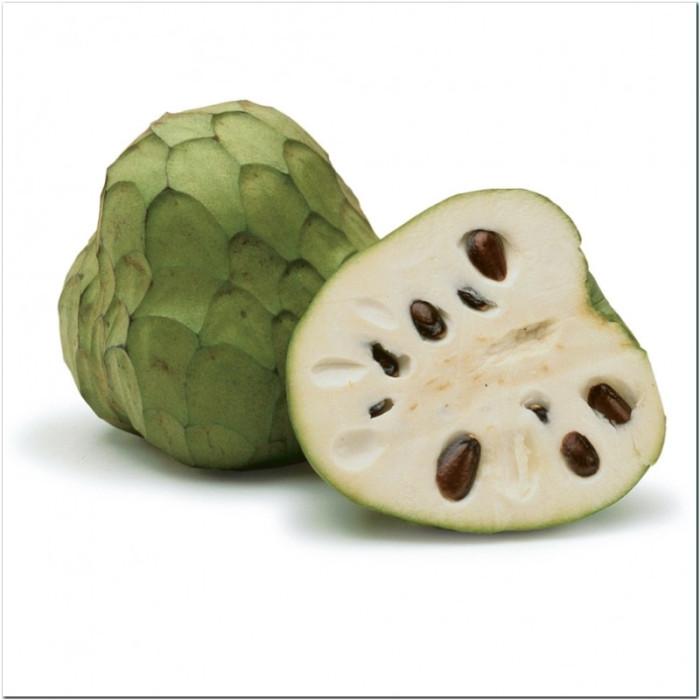Cherimoya or chirimoya and called chirimuya / Annona cherimola
Lush, bushy tree, in room conditions grows up to 3 m tall. Young shoots are pubescent. The flowers are fragrant, greenish in color, arranged singly or in groups of 2-3. The flowers are bisexual, self-pollination is impossible, so it is necessary to pollinate manually. The fruits are similar in size and appearance to apples. The peel is thin, the flesh is very tasty and fragrant.
The large, green cherimoya fruit is heart-shaped and divided into segments. Inside the fruit is a fragrant, creamy, fibrous pulp with dark seeds. The seeds should not be consumed as they are toxic. The fruit can be about 18 cm long and up to 10 cm wide, weighing from 0.2 to 3 kg. The taste of cherimoya is delicate, closer to sweet, reminiscent of a combination of flavors: pineapple, strawberry, mango, banana and cream.
Application. Basically, cherimoya is eaten fresh, cutting the fruit into two parts, the pulp can be collected with a spoon. In drinks, desserts, salads, it is an exotic addition.
Benefit. Cherimoya is an excellent food due to its beneficial composition of nutrients. Cherimoya fruits are rich in carbohydrates, proteins, folic acid, mineral elements, sugar (fructose, sucrose, glucose), vitamins, organic acids.
A feature of cherimoya is a high content of potassium, the use of which helps to remove excess fluid from the body. Normalizes the acidity of gastric juice, promotes weight loss, improves liver function, as it is rich in fiber. Cherimoya contains B vitamins, is useful for the nervous system, improves skin condition.
Grafting is not required, the fruits have an excellent taste and are known as the «ice cream tree».
Agricultural technology:
The location calls for well lit, better filtered light. In summer, you can take it out to the garden or to the balcony. Afraid of drafts. Cherimoya is drought-resistant, watering is sufficient, without stagnant moisture.
Fertilize in spring and summer 1 time in 2 weeks with a complete mineral fertilizer. It is not demanding on the composition of the earth, it grows even on poor and alkaline soils. In summer, the ideal temperature is 20-25°C, and in winter about 10-15°C.
Seeds need to be scarified before planting, this will speed up germination (without scarification, the seeds also germinate, but for a long time and the percentage of germination is much lower). Soak for 1-2 days in very warm water, plant to a depth of 1-2 cm, cover. Germinate in a bright and warm (25 ° C and above) place. Cuttings are rooted in spring and early summer in wet sand.

No questions about this product, be the first and ask your question.


























